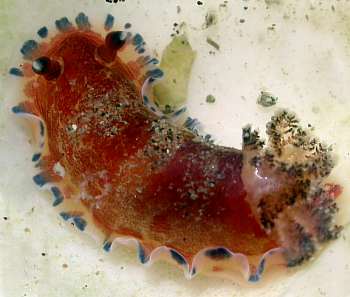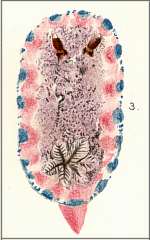Rediscovery of Doris elizabethina Kelaart
March 5, 2004
From: Bill Rudman


PHOTOS: Upper: On algae in a sandy tidal channel bordered by mangroves, 25cm at low tide, 1.5 - 2cm long. Locality: Khawr Kalba, United Arab Emirates, Gulf of Oman, 16 Feb. 2004. Photo: Henk Dekker
Lower: Painting from Kelaart's collection from Eliot (1906) - Plate XLIII, Fig. 3. Doris elizabethina.
The external colour of this species was described from Ceylon (Kelaart, 1859) and Eliot (1906) subsequently published a colour plate from Kelaart's collections. In a second part of his review of Kelaart's species (Eliot, 1907), Eliot noted that although this species had the appearance of a chromodorid, the mantle was quite wide and the branched gills were abnormal for that family. Since that time no similarly coloured animal has been described from the Indian Ocean, until Henk Dekker's message [#12327] from the Gulf of Oman.
The animal in Dekker's photo matches Kelaart's painting in all respects, the only minor variation being that in Kelaart's painting the posterior foot is all a reddish colour, while in Dekker's animal the posterior part of the foot is translucent white with a broad reddish band down the midline.
Copied here is Kelaart's full description:
Body half an inch long. Mantle broad, spotted with purple on the back; margin white, spotted with large light-blue spots. A row of crimson spots between the line of blue spots and the purple-coloured back. Under surface of mantle whitish, with a pink shade. Tentacles purplish brown, white tipped, laminated. Branchiae six, small, bipinnated, of a grizzled grey colour. Foot whitish upper surface crimson. Mouth with a small veil. This elegantly coloured Doris was obtained in deep water near the Pearl Banks of Aripo. I have named it in compliment to one who takes more than an ordinary interest in my zoological pursuits." Kelaart, 1859 p. 267.
I have puzzled over this species for many years. Its colours certainly suggest it is perhaps a chromodorid, but as Eliot suggested, the gills as illustrated, would be unusual in that genus. The similarity between the original painting and Dekker's photos is remarkable and leaves no doubt in my mind that it is the same species. From Dekker's photo there can be little doubt that this is a species of Dendrodoris. Eliot could not find a specimen or radular mount in Kelaart's collection at the Natural History Museum in Newcastle-on-Tyne which is what we might expect if the animal was a species of Dendrodoris, which lack a radula. I have subsequently visited the collection in Newcastle-on-Tyne and was unable to find a specimen or radula mount. The only species of Dendrodoris which approaches this species in colour is the South African species D. caesia, and it is possible that this will prove to be a synonym.
Kelaart's use of the name Doris elizabethina seems to be the earliest use of the name. It should not be confused with Chromodoris elizabethina Bergh, 1875 or Chromdoris elisabethina Bergh, 1877.
References:
• Kelaart, E.F. (1859). On some additional species of nudibranchiate mollusks from Ceylon. Annals & Magazine of Natural History, 4: 267-270
• Eliot, C.N.E. (1906) On the nudibranchs of Southern India and Ceylon, with special reference to the drawings by Kelaart and the collections belonging to Alder & Hancock preserved in the Hancock Museum at Newcastle-on-Tyne. Proceedings of the Zoological Society of London, [for 1906] 2: 636-691. (Pls. 42-47). [Plate XLIII. Fig. 3 Doris elizabethina
• Eliot, C.N.E. (1907) On the nudibranchs of Southern India and Ceylon, with special reference to the drawings by Kelaart and the collections belonging to Alder and Hancock, preserved in the Hancock Museum at Newcastle-on-Tyne, No. 2. Proceedings of the Zoological Society of London [for 1906]: 999-1008.
Best wishes
Bill Rudman
Related messages
-
Dendrodoris elizabethina from Gulf of Oman
From: Henk Dekker, March 5, 2004
